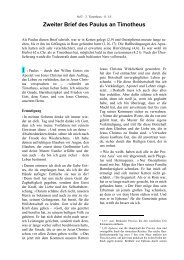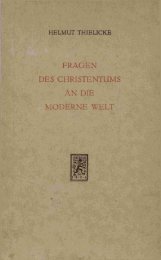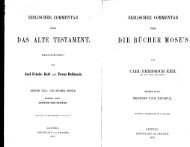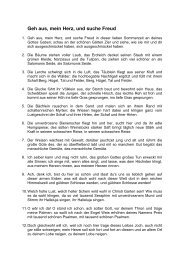Create successful ePaper yourself
Turn your PDF publications into a flip-book with our unique Google optimized e-Paper software.
each case. We can only stand amazed at how the<br />
Creator solved this problem, which is why it is<br />
worth giving a little more detail:<br />
Carrying out these specific functions requires an<br />
extraordinarily ingenious molecular construction.<br />
It is the hemoglobin molecule (Hb), which chemically<br />
is a tetrameric iron protein. It consists of a<br />
globin molecule and four heme molecules. Globin<br />
consists of four subunits, namely four long<br />
protein chains (two lots of identical type, i.e. two<br />
pairs). A heme molecule is attached to each of<br />
these chains such that the four heme units lie in<br />
“pouches” close to the surface of the entire Hb<br />
molecule. Heme is a ringshaped molecule, which<br />
contains an iron atom at its centre. Hb consists<br />
of 0.334% iron; the total quantity of iron in the<br />
blood is about 3 grams, or 70% of the iron in the<br />
entire human body.<br />
Protein molecules consist of long chains of various<br />
amino acids, and undergo folding after they<br />
have been assembled. The characteristic threedimensional<br />
structure each protein adopts, which<br />
gives it its function, depends on the types and<br />
sequence of these amino acids. If just a few<br />
(depending on the position, even one) of these<br />
amino acids are substituted by others, or amino<br />
acids are added or omitted, the entire geometry<br />
of the molecule is affected, and thus also its<br />
capacity for gas transport.<br />
62<br />
a) In the adult stage (here regarded as commencing<br />
at birth), our blood contains exactly that<br />
hemoglobin (HbA = adult) in which the four protein<br />
chains are constructed so as to give the<br />
entire molecule the precise affinity for oxygen<br />
needed for us to live. HbA has two each of the<br />
already mentioned α und β protein chains. The<br />
chemical structure of these chains must be very<br />
precise, or else severe diseases (anemias) will<br />
result. For instance, sickle cell anemia has arisen<br />
through mutation causing just one single amino<br />
acid residue in the β chain to be replaced by<br />
another. Even this minuscule change results in<br />
an aberrant, pathological form of Hb. We can see<br />
here that the sort of tinkering and experimentation<br />
with amino acid sequences that evolutionary<br />
thinking requires is largely ruled out. The hemoglobin<br />
molecule must be fully functional right<br />
from the start.<br />
b) In the embryonic stage (up to 3 months gestation)<br />
the oxygen transport needs are radically<br />
different. What has the Creator done to cater for<br />
this situation? He has specified the amino acid<br />
sequences in two of the protein chains in the<br />
hemoglobin molecules such that the spatial configuration<br />
after folding results in exactly the oxygen<br />
affinity required. Compared to HbA, instead<br />
of the two β chains there are two ε chains.<br />
Embryonic hemoglobin is thus also called Hbα 2 ε 2<br />
c) In the fetal stage (from 3 months gestation to<br />
birth), the oxygen requirements are different<br />
again. Now the two ε chains of the embryonic<br />
hemoglobin (Hbα 2 ε 2 ) are replaced by two γ<br />
chains. It is now called Hbα 2 ε 2 or HbF (= fetal).<br />
Throughout its development, the fetus must<br />
remain richly supplied with oxygen. Exchanges<br />
of respiratory gases and energy-laden substances<br />
take place in the placenta. If the fetus had the<br />
normal adult hemoglobin HbA, the blood would<br />
be only 60% saturated. Thus the Creator has for<br />
this stage provided the HbF, which is precisely<br />
tuned to the coupling of the fetal and maternal<br />
circulation. Because of its special 3-D structure,<br />
HbF can take up 20-30% more oxygen from the<br />
mother’s blood than HbA. The later replacement<br />
of HbF by HbA occurs through a remarkable<br />
process. Already prior to birth, a “switch of programming”<br />
takes place such that at birth the erythrocytes<br />
only contain some 60-80% of fetal<br />
hemoglobin. At three months of age, the HbF<br />
hemoglobin has been almost completely replaced<br />
by the HbA hemoglobin. It is amazing how all<br />
these processes take place in a completely goaldirected<br />
fashion, in response to the changing circumstances<br />
and needs.<br />
If one were to try to explain the origin of hemoglobin,<br />
and the complex machinery for its synthesis,<br />
from an evolutionary standpoint, there<br />
would be some massively insoluble problems:<br />
●<br />
How is it, that in all the three stages of<br />
human development described above, the<br />
exact chemical makeup (the sequences and
















